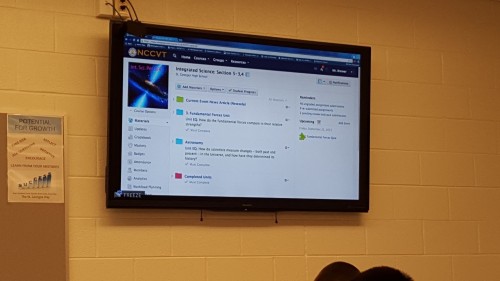Rodel Teacher Council Member Spotlight: Tim Brewer
Have you ever wondered what it would be like to be a fly on the wall while a teacher explained the concept of “spaghettification” to a class full of teenagers, half of whom were listening raptly and the other half of whom were exploding with further questions? I got that chance a few weeks ago when I sat in on Rodel Teacher Council member Tim Brewer’s science classes at St. Georges High School. As engrossing as spaghettification is, what stuck with me most was more how he was teaching, as opposed to what.

Some things never change: Students still dig into the periodic table in Tim Brewer’s chemistry class, even as he has changed to a blended learning model.
For the past two years, Tim has been piloting blended learning in his classroom as part of the BRINC consortium’s blended learning work. In Tim’s room, that means that when I walked in, students were taking their weekly quiz online on Schoology, and Tim got instant updates on students’ scores as they finished. It means that most of the materials for Tim’s courses are posted online, while many of the activities in the course are self-paced and flexible based on students’ interests.

All eyes: Tim’s students can follow along on Schoology as he manipulates the monitor to show them how to find their course materials.
As I watched the classes unfold, I noticed both how Tim had to adjust his teaching practices to make his classroom truly blended, as well as how students had to adjust some of their own practices, with Tim’s guidance and support. Most of the students in the classes I observed, while generally quite tech savvy (lots of smartphones in the room), hadn’t been taught in a blended setting before. It’s still the beginning of the school year, and they were definitely still making the transition to figure out how to navigate the different environment.
For instance, in a blended learning environment, many of the activities students complete are self-paced and vary based on students’ interests. Ultimately, this means that students “own” their work in more meaningful ways, especially in high school. This is good, but is obviously a big transition if students are used to a more traditional model. To help his students be successful in this environment, Tim devised a simple, low-tech solution: a to-do list.
I visited on a Friday when students were wrapping up a unit and beginning to discuss new content. After he introduced the content and laid out what students would be responsible for at the end of the following week, Tim handed out to-do lists charted out for the week, and students got to work organizing their projects and tasks for the week ahead.

Low-tech, high reward: Students in Tim Brewer’s classroom use “old-fashioned” to-do lists to help manage their time and tasks in a blended learning setting.
This simple tool helped Tim solve a problem he identified early on as his students made the transition from a traditional setting to a blended setting, where they had more ownership and control over what and when and how they learned: They were overwhelmed by the freedom they had and struggled with how to use their time effectively.
Clearly, even though Tim didn’t explicitly teach a lesson on time management, personal responsibility, or organization skills, his students are learning valuable tricks and tools in these areas that will be valuable to them in a variety of different settings, from higher education to the workplace.
Thanks for letting me visit, Tim! And if you’re still wondering about spaghettification, here’s another link to check out.
Related Topics: brinc, Delaware, Delaware teachers, Rodel Teacher Council, Schoology, St. Georges